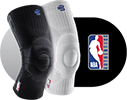The Ups and Downs of Jumper’s Knee
Symptoms, Causes and Treatment Options for Jumper’s Knee

Whether you’re having fun on the family trampoline or playing weekend games of three-on-three on the basketball court, it’s all fun and games until your knees scream in pain the next day.
Jumper’s knee (also called patellar tendinitis) will first make itself known as a small pain below the kneecap when you bend your knee. Continuing to perform the same bending or jumping action will further inflame this tendon, and can even cause tiny tears.
Identifying Jumper’s Knee
Jumper’s knee differs from runner’s knee in that along with the pain that occurs when your foot strikes the ground, you will also likely feel a slight swelling right below the kneecap.
Place the fingertips of each hand on the soft area just below each kneecap. This is your patellar tendon. If the knee is experiencing pain when you jump and land, and feels slightly more swollen, this is a strong indication that it’s time to take a break for about a week from any regular activities that require running or jumping.
Treating Jumper’s Knee
The swollen tendon needs time to repair. You can help bring down the swelling of jumper’s knee by following the RICE method: Rest, Ice, Compression and Elevation.
The good news is that jumper’s knee won’t keep you sidelined for long if you address the pain early enough. You can begin to ease back into your fitness activities when the swelling below the knee has disappeared and you no longer feel a dull or sharp pain when jumping or squatting.
Ignoring this swelling and continuing with your regular activities will only aggravate the jumper’s knee and cause further and potentially more serious damage to both the tendon and other areas of the knee.
Jumper’s Knee Prevention
To prevent a reinjury to your jumper’s knee, you should consider adding weight-training exercises that target the gluteals, quadriceps and hamstrings. Strengthening these powerful muscles will ease the load on the tendons in your knee and help you enjoy your favorite activities without further knee pain.
Regular stretching will also help to loosen your muscles in preparation for activity and to help with recovery afterward. Muscles that are “warmed up” before high-impact exercises like running and jumping promote joint flexibility and help to prevent jumper’s knee.
Best Brace for Jumper’s Knee
Of course, your daily activities make it practically impossible to give the knee complete rest if you feel you are suffering from jumper’s knee. So in conjunction with your RICE therapy, you’ll want to give the knee added support with a medical-grade compression knee brace.
The Sports Knee Support NBA knee brace is designed to help relieve and prevent jumper’s knee pain and stabilize the joint so you can move with confidence and comfort both during rest and as you return to activity.




